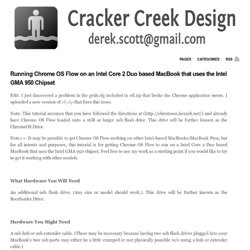

Run Chrome OS From a USB Stick or as a Virtual Machine - TechSpot Guides. Chrome OS notebooks from Acer and Samsung are expected to launch next month at $349 and $429, respectively. The fact that you can get a more powerful netbook with Windows 7 pre-installed for roughly the same price, or even less, is already putting some people off . But that doesn't mean you should disregard Google's operating system without so much as giving it a try -- especially since it's available as a free download for you to test on your own hardware. Google Chrome OS is to Chromium OS what the Google Chrome browser is to Chromium. It's essentially Chrome OS's open source brother, used primarily by developers, with code that is available for anyone to checkout, modify, and build. While you'd normally have to build Chromium OS from source to try it out on your computer, several developers have released installable builds that will save you the trouble.
Virtualization Through VirtualBox Extract the image file using an application like 7-Zip or WinRAR , so you get a .vdi file. Want To Try Out Google Chrome OS For Yourself? Here's How. The public debut of Google Chrome OS today has the press abuzz over the potential of the new web-based operating system. And now that it’s open sourced, you have the chance to try it out for yourself. Unfortunately, most people aren’t ready to undertake the daunting task of actually taking Google’s recently open-sourced code and turning that into a bootable computer. So we’ve put together a step-by-step guide to doing this, for free, in around 15 minutes (depending on how long it takes to download the OS itself).
No, this won’t get your computer booting Chrome OS natively (and frankly, you probably wouldn’t want to yet anyway). But it will get it up and running in a virtual machine using the free software VirtualBox, which is available for Macs, PCs, and Linux. First, a few caveats: we didn’t create the Chrome OS build ourselves — it was downloaded from BitTorrent. Digg_url = ‘ Running Chrome OS Flow on an Intel Core 2 Duo based MacBook that uses the Intel GMA 950 Chipset « Cracker Creek Design. Edit: I just discovered a problem in the grub.cfg included in efi.zip that broke the Chrome application menu.

I uploaded a new version of efi.zip that fixes this issue. Note: This tutorial assumes that you have followed the directions at ( and already have Chrome OS Flow loaded onto a 2GB or larger usb flash drive. This drive will be further known as the ChromeOS Drive. Note++: It may be possible to get Chrome OS Flow working on other Intel-based MacBooks/MacBook Pros, but for all intents and purposes, this tutorial is for getting Chrome OS Flow to run on a Intel Core 2 Duo based MacBook that uses the Intel GMA 950 chipset. Feel free to use my work as a starting point if you would like to try to get it working with other models. What Hardware You Will Need An additional usb flash drive. Hardware You Might Need A usb hub or usb extender cable. Preparing the Bootloader Drive Open Disk Utility, select your Bootloader Drive, click the Erase tab and format your drive as “MS-DOS (FAT)”. Joli OS Review: Is it the Best OS Available for Netbooks?
15 Things I Did After Installing New Ubuntu 11.10 Oneiric Ocelot. Programming general. GRUB. Multiboot Specification version 0.6.96. Multiboot Specification This file documents Multiboot Specification, the proposal for the boot sequence standard.

This edition documents version 0.6.96. Copyright © 1995,96 Bryan Ford <baford@cs.utah.edu> Copyright © 1995,96 Erich Stefan Boleyn <erich@uruk.org> Copyright © 1999,2000,2001,2002,2005,2006,2009 Free Software Foundation, Inc. Permission is granted to make and distribute verbatim copies of this manual provided the copyright notice and this permission notice are preserved on all copies. 1 Introduction to Multiboot Specification This chapter describes some rough information on the Multiboot Specification. 1.1 The background of Multiboot Specification Every operating system ever created tends to have its own boot loader.
Chaining mechanisms can be a nightmare. 1.2 The target architecture This specification is primarily targeted at pc, since they are the most common and have the largest variety of operating systems and boot loaders. 1.3 The target operating systems.